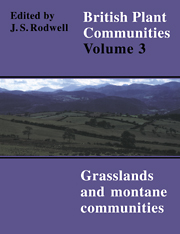Book contents
- Frontmatter
- Contents
- List of Figures
- Preface and Acknowledgements
- Preamble
- Mesotrophic Grasslands
- Community Descriptions
- Calcicolous Grasslands
- Community Descriptions
- Calcifugous Grasslands and Montane Communities
- Community Descriptions
- Index of Synonyms to Grasslands and Montane Communities
- Index of Species in Grasslands and Montane Communities
- Bibliography
CG13 - Dryas Octopetala-Carexflacca Heath
Published online by Cambridge University Press: 04 July 2020
- Frontmatter
- Contents
- List of Figures
- Preface and Acknowledgements
- Preamble
- Mesotrophic Grasslands
- Community Descriptions
- Calcicolous Grasslands
- Community Descriptions
- Calcifugous Grasslands and Montane Communities
- Community Descriptions
- Index of Synonyms to Grasslands and Montane Communities
- Index of Species in Grasslands and Montane Communities
- Bibliography
Summary
Synonymy
Dryas heaths Poore & McVean 1957, Gimingham 1972p.p.; Dryas-Carexflacca nodum McVean & Ratcliffe 1962; Dryas-Carex rupestris nodum McVean & Ratcliffe 1962 p.p.; Plantagino-Dryadetum Shimwell 1968a; Dryas octopetala localities Elkington 1971 p.p.; Invernarver Calluna-Arctostaphylos heath Ward 1971a; Dryas octopetala heath Ratcliffe 1977 p.p.
Constant species
Bellis perennis, Carex flacca, Dryas octopetala, Festuca ovina, Linum catharticum, Lotus corniculatus, Plantago lanceolata, P. maritima, Thymus praecox, Viola riviniana, Ditrichum flexicaule.
Rare species
Agropyron donianum, Alchemilla glaucescens, Arctostaphylos uva-ursi, Arenaria norvegica ssp. norvegica, Carex capillaris, C. rupestris, Draba incana, Dryas octopetala, Epipactis atrorubens, Oxytropis halleri, Amblystegium compactum, Brachythecium erythrorrhizon, Schistidium apocarpum var. homodictyon, S. trichodon, Seligeria trifaria, Tortella densa.
Physiognomy
The Dryas octopetala-Carex flacca heath has a low patchy cover of sub-shrubs over what is essentially a sub-montane grassland sward. D. octopetala is usually the most abundant species, though its appearance (and the look of the vegetation as a whole) varies with the amount of grazing: in close-cropped swards, it has a prostrate much-nibbled habit but where there is no grazing it can grow more bushy and floriferous. Even in ungrazed stands, however, the plants often have small leaves, which suggests some genotypic distinction from the forms typical of the montane Dryas-Silene community (Elkington 1971). Intermixed with the D. octopetala there is commonly, in one sub-community, some Calluna vulgaris and, in the other, a little Salix repens and Empetrum nigrum ssp. nigrum (less often E. nigrum ssp. hermaphroditum). Very occasionally, Arctostaphylos uva-ursi is found and, in some stands, it replaces D. octopetala in vegetation which is otherwise unchanged (e.g. Ward 1971a, b, Birks 1973). Thymus praecox is constant and locally abundant.
Grasses and sedges show considerable diversity in one sub-community but the species common throughout are few. Festuca ovina and Carex flacca are both constant and they often make up the bulk of the sward between the sub-shrubs but other species are only occasional and rarely abundant: Koeleria macrantha, Agrostis capillaris, Festuca rubra and Carex panicea. Festuca vivipara has been recorded in only one of the sub-communities
Although some montane species occur in this vegetation (including certain Arctic-Alpines which attain their lowest altitudinal limit in the community), most of the other common herbaceous associates are species well represented in the more calcicolous sub-montane grasslands.
- Type
- Chapter
- Information
- British Plant Communities , pp. 259 - 266Publisher: Cambridge University PressPrint publication year: 1992

